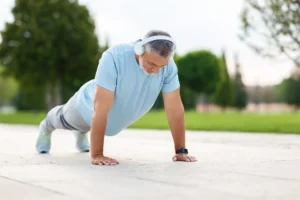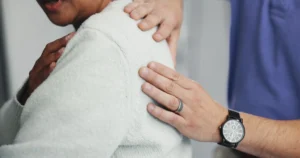The structure and anatomy of the shoulder makes up one of the most complex joints in our body. It is an essential part of the human body, playing a crucial role in daily activities and sports. Its complex structure allows for an impressive range of motion and flexibility, but also makes it susceptible to many injuries.
In this blog, I will explain the anatomy of the shoulder, including its bones, muscles, and ligaments, to help you better understand this remarkable joint.
Bones of the Shoulder
The bones of the shoulder play a crucial role in providing structure, stability, and mobility to this highly versatile joint. Made up of the clavicle, scapula, and humerus, these bones interact to form the foundation for a wide range of movements, from lifting and throwing to reaching and rotating. Understanding the importance of the shoulder bones and their intricate interactions is key to maintaining shoulder health, preventing injuries, and ensuring optimal performance in daily activities and sports.
The clavicle (collarbone) is a horizontal bone that connects the sternum (breastbone) to the scapula (shoulder blade). It plays a crucial role in supporting the shoulder joint and transferring forces from the arm to the trunk.
The scapula (shoulder blade) is a large, flat, triangular bone that forms the back part of the shoulder joint. Its main parts include the spine, acromion, and coracoid process. The scapula moves in coordination with the clavicle and humerus to enable various shoulder movements.
The humerus (upper arm bone) is the long bone of the upper arm, connecting the scapula to the lower arm bones. Its rounded head articulates with the glenoid cavity of the scapula, forming the glenohumeral joint.

Shoulder Joint Types
The shoulder joint is a complex and sophisticated system that includes multiple joint types, working in harmony to provide mobility and strength.
The glenohumeral joint, also known as the ball-and-socket joint, is the primary joint of the shoulder. It is formed by the head of the humerus and the glenoid cavity of the scapula. This joint is responsible for the majority of the shoulder’s wide range of motion.
The acromioclavicular joint (AC joint) connects the clavicle to the scapula’s acromion process. It provides stability to the shoulder and allows for some rotation and movement in the joint.
The sternoclavicular joint is where the clavicle meets the sternum. This joint plays a critical role in overall shoulder movement by enabling the clavicle to move in various directions.
Muscles of the Shoulder
The rotator cuff is a group of four muscles (supraspinatus, infraspinatus, teres minor, and subscapularis) that provide stability to the glenohumeral joint. They work together to keep the humerus securely in the glenoid cavity during movement.
The deltoid muscle covers the shoulder joint and is responsible for many shoulder movements. It has three parts: anterior, lateral, and posterior, which work together to provide strength and stability to the joint.
The trapezius is a large, flat muscle that extends from the neck to the lower back. Its upper, middle, and lower fibers contribute to various shoulder movements and help maintain proper posture and stability.
Other muscles that support the shoulder joint include the pectoralis major and minor, latissimus dorsi, teres major, and rhomboids. These muscles assist in various movements and help stabilize the joint.
Ligaments of the Shoulder
The ligaments of the shoulder play a vital role in providing stability and function to this complex joint. By understanding their roles and interactions, we can better appreciate the intricate balance required to maintain shoulder health. It’s important to strengthen these ligaments through proper exercise and posture, as well as seeking professional help if you experience shoulder pain.
The glenohumeral ligaments (GHL) are a group of three ligaments (superior, middle, and inferior) that help maintain shoulder joint stability by connecting the humerus to the scapula.
The coracoclavicular ligaments are a pair of ligaments that connect the clavicle to the coracoid process, a small hook-like structure on the scapula. They consist of the conoid ligament and the trapezoid ligament.
The acromioclavicular ligament connects the clavicle to the scapula’s acromion process, forming the AC joint. This ligament strengthens and stabilizes the joint, allowing for smooth and coordinated movement between the clavicle and scapula during shoulder motion.
Shoulder Injuries
Common shoulder injuries and conditions can significantly impact one’s quality of life, as they often limit mobility and cause pain. Among these conditions are rotator cuff tears, which involve damage to one or more of the four rotator cuff muscles, resulting in pain and weakness during shoulder movements. Frozen shoulder, or adhesive capsulitis, is another prevalent issue that causes stiffness and a decreased range of motion in the joint due to inflammation and scarring of the shoulder capsule. Shoulder dislocations, which occur when the humerus is forced out of the shoulder socket, can be extremely painful and cause damage to surrounding ligaments and muscles. Lastly, shoulder impingement syndrome arises when the tendons of the rotator cuff become compressed and irritated, leading to pain and restricted movement. Preventive measures such as proper exercise, stretching, and maintaining good posture can help mitigate the risk of these common shoulder injuries and conditions.
As a shoulder and elbow specialist, I dedicate my time to making sure that I’m up to date on the most recent technology and products that are available to treat my patients suffering from shoulder and elbow conditions.
If you are experiencing symptoms related to your shoulder, please make an appointment to see me so we can discuss your treatment options.





